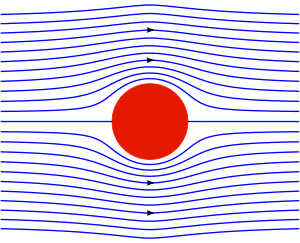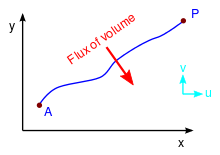Stream function
The stream function is defined for incompressible (divergence-free) flows in two dimensions – as well as in three dimensions with axisymmetry. The flow velocity components can be expressed as the derivatives of the scalar stream function. The stream function can be used to plot streamlines, which represent the trajectories of particles in a steady flow. The two-dimensional Lagrange stream function was introduced by Joseph Louis Lagrange in 1781.[1] The Stokes stream function is for axisymmetrical three-dimensional flow, and is named after George Gabriel Stokes.[2]

Considering the particular case of fluid dynamics, the difference between the stream function values at any two points gives the volumetric flow rate (or volumetric flux) through a line connecting the two points.
Since streamlines are tangent to the flow velocity vector of the flow, the value of the stream function must be constant along a streamline. The usefulness of the stream function lies in the fact that the flow velocity components in the x- and y- directions at a given point are given by the partial derivatives of the stream function at that point. A stream function may be defined for any flow of dimensions greater than or equal to two, however the two-dimensional case is generally the easiest to visualize and derive.
For two-dimensional potential flow, streamlines are perpendicular to equipotential lines. Taken together with the velocity potential, the stream function may be used to derive a complex potential. In other words, the stream function accounts for the solenoidal part of a two-dimensional Helmholtz decomposition, while the velocity potential accounts for the irrotational part.
Two-dimensional stream function
Definitions

Lamb and Batchelor define the stream function – in the point with two-dimensional coordinates and as a function of time – for an incompressible flow by:[3]
So the stream function is the volume flux through the curve , that is: the integral of the dot product of the flow velocity vector and the normal to the curve element The point is a reference point defining where the stream function is zero: a shift of results in adding a constant to the stream function
An infinitesimal shift of the position results in a stream function shift:
which is an exact differential provided
This is the condition of zero divergence resulting from flow incompressibility. Since
the flow velocity components have to be
in relation to the stream function
Definition by use of a vector potential
The sign of the stream function depends on the definition used.
One way is to define the stream function for a two-dimensional flow such that the flow velocity can be expressed through the vector potential
Where if the flow velocity vector .
In Cartesian coordinate system this is equivalent to
Where and are the flow velocity components in the cartesian and coordinate directions, respectively.
Alternative definition (opposite sign)
Another definition (used more widely in meteorology and oceanography than the above) is
- ,
where is a unit vector in the direction and the subscripts indicate partial derivatives.
Note that this definition has the opposite sign to that given above (), so we have
in Cartesian coordinates.
All formulations of the stream function constrain the velocity to satisfy the two-dimensional continuity equation exactly:
The last two definitions of stream function are related through the vector calculus identity
Note that in this two-dimensional flow.
Derivation of the two-dimensional stream function
Consider two points A and B in two-dimensional plane flow. If the distance between these two points is very small: δn, and a stream of flow passes between these points with an average velocity, q perpendicular to the line AB, the volume flow rate per unit thickness, δΨ is given by:
As δn → 0, rearranging this expression, we get:
Now consider two-dimensional plane flow with reference to a coordinate system. Suppose an observer looks along an arbitrary axis in the direction of increase and sees flow crossing the axis from left to right. A sign convention is adopted such that the flow velocity is positive.
Flow in Cartesian coordinates
By observing the flow into an elemental square in an x-y Cartesian coordinate system, we have:
where u is the flow velocity parallel to and in the direction of the x-axis, and v is the flow velocity parallel to and in the direction of the y-axis. Thus, as δn → 0 and by rearranging, we have:
Continuity: the derivation
Consider two-dimensional plane flow within a Cartesian coordinate system. Continuity states that if we consider incompressible flow into an elemental square, the flow into that small element must equal the flow out of that element.
The total flow into the element is given by:
The total flow out of the element is given by:
Thus we have:
and simplifying to:
Substituting the expressions of the stream function into this equation, we have:
Vorticity
The stream function can be found from vorticity using the following Poisson's equation:
or
where the vorticity vector – defined as the curl of the flow velocity vector – for this two-dimensional flow has i.e. only the -component can be non-zero.
Proof that a constant value for the stream function corresponds to a streamline
Consider two-dimensional plane flow within a Cartesian coordinate system. Consider two infinitesimally close points and . From calculus we have that
Say takes the same value, say , at the two points and , then is tangent to the curve at and
implying that the vector is normal to the curve . If we can show that everywhere , using the formula for in terms of , then we will have proved the result. This easily follows,
Properties of the stream function
- The stream function is constant along any streamline.
- For a continuous flow (no sources or sinks), the volume flow rate across any closed path is equal to zero.
- For two incompressible flow patterns, the algebraic sum of the stream functions is equal to another stream function obtained if the two flow patterns are super-imposed.
- The rate of change of stream function with distance is directly proportional to the velocity component perpendicular to the direction of change.
References
Citations
- Lagrange, J.-L. (1868), "Mémoire sur la théorie du mouvement des fluides (in: Nouveaux Mémoires de l'Académie Royale des Sciences et Belles-Lettres de Berlin, année 1781)", Oevres de Lagrange, Tome IV, pp. 695–748
- Stokes, G.G. (1842), "On the steady motion of incompressible fluids", Transactions of the Cambridge Philosophical Society, 7: 439–453, Bibcode:1848TCaPS...7..439S
Reprinted in: Stokes, G.G. (1880), Mathematical and Physical Papers, Volume I, Cambridge University Press, pp. 1–16 - Lamb (1932, pp. 62–63) and Batchelor (1967, pp. 75–79)
Sources
- Batchelor, G. K. (1967), An Introduction to Fluid Dynamics, Cambridge University Press, ISBN 0-521-09817-3
- Lamb, H. (1932), Hydrodynamics (6th ed.), Cambridge University Press, republished by Dover Publications, ISBN 0-486-60256-7
- Massey, B. S.; Ward-Smith, J. (1998), Mechanics of Fluids (7th ed.), UK: Nelson Thornes
- White, F. M. (2003), Fluid Mechanics (5th ed.), New York: McGraw-Hill
- Gamelin, T. W. (2001), Complex Analysis, New York: Springer, ISBN 0-387-95093-1
- "Streamfunction", AMS Glossary of Meteorology, American Meteorological Society, retrieved 2014-01-30